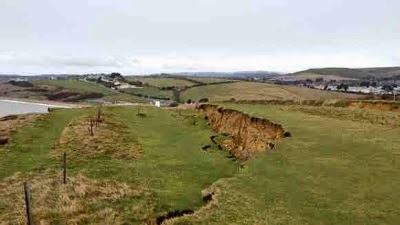A large section of cliff at Penarth in the Vale of Glamorgan, roughly 8.4 km southwest of Cardiff, has collapsed onto the foreshore. The incident happened at about 12.40 pm British Summertime (about 11.40 am GMT) on Sunday 13 April 2014. South Wales Fire and Rescue Service report about 30 tonnes of material on the beach, and while there are no reports of any injuries, they are asking people to stay away until the area is made safe. The Penarth area has suffered flooding in recent days due to a combination of heavy rainfall and high tides. Landslides are a common problem after severe weather events, as excess pore water pressure can overcome cohesion in soil and sediments, allowing them to flow like liquids. Approximately 90% of all landslides are caused by heavy rainfall.
The cliffs at Penarth on Sunday 13 April 2014. Claire Saralis/BBC.
While such events are hazardous, and coastal erosion a concern for communities in the areas where it occurs, they are not without their positive side. The cliffs at Penarth are a popular site with fossil collectors, but are often considered to be somewhat overworked. Periodic rockfalls expose new rockface, and provide a supply of detached fossils on the foreshore.
The approximate location of Penarth Cliffs. Google Maps.
The cliffs at Penarth comprise Jurassic sandstones and limestone beds overlying darker Triassic mudstones. While the Triassic beds are largely lacking in fossils, the Jurassic beds produce numerous Brachiopods, Bivalves, Gastropods and Ammonites.
An Ammonite fossil from Penarth. UK Fossils Network.
See also...
Follow Sciency Thoughts on Facebook.






